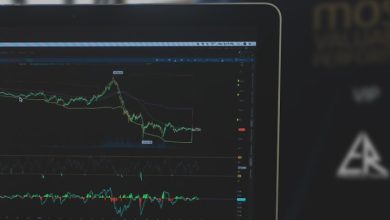Volatility Patterns in Major Cryptocurrencies

- Understanding Volatility in Cryptocurrencies
- Analyzing the Fluctuations of Major Cryptocurrencies
- The Impact of Market Trends on Cryptocurrency Volatility
- Comparing Volatility Patterns Across Different Cryptocurrencies
- Strategies for Managing Risk in a Volatile Cryptocurrency Market
- Exploring the Relationship Between Volatility and Price Movements in Cryptocurrencies
Understanding Volatility in Cryptocurrencies
Cryptocurrencies are known for their high volatility, which can be both a blessing and a curse for investors. Understanding the nature of this volatility is crucial for anyone looking to trade or invest in digital assets.
Volatility in cryptocurrencies refers to the degree of variation in their price over a specific period. This volatility is influenced by a variety of factors, including market demand, regulatory developments, technological advancements, and macroeconomic trends.
One of the main reasons for the high volatility of cryptocurrencies is their relatively small market size compared to traditional assets. This means that even small buy or sell orders can have a significant impact on prices.
It is essential for investors to be aware of the risks associated with this volatility and to have a clear risk management strategy in place. Diversifying your portfolio, setting stop-loss orders, and staying informed about market trends can help mitigate some of these risks.
Despite the challenges posed by volatility, many investors are drawn to cryptocurrencies because of the potential for high returns. By understanding the patterns and drivers of volatility in the crypto market, investors can make more informed decisions and potentially profit from this dynamic asset class.
Analyzing the Fluctuations of Major Cryptocurrencies
Cryptocurrencies are known for their high levels of volatility, which can present both opportunities and risks for investors. Analyzing the fluctuations of major cryptocurrencies is crucial for understanding market trends and making informed investment decisions. By examining historical price data, experts can identify patterns and predict potential future movements. It is essential to consider factors such as market sentiment, regulatory developments, and technological advancements when analyzing volatility in cryptocurrencies. Traders and investors must stay updated on market news and trends to navigate the ever-changing landscape of digital assets effectively.
The Impact of Market Trends on Cryptocurrency Volatility
The **impact** of **market trends** on **cryptocurrency** **volatility** is a complex and dynamic relationship that plays a significant role in shaping the fluctuations of **major cryptocurrencies**. **Market trends** refer to the general direction in which the **cryptocurrency** **market** is moving, such as **bullish** or **bearish** **trends**, **market** **sentiment**, and **macroeconomic** factors. These **trends** can have a profound effect on the **volatility** of **cryptocurrencies**, leading to **price** swings and **trading** **opportunities** for **investors** and **traders**.
During **bullish** **market** **conditions**, when **investors** are **optimistic** about the **future** **growth** of **cryptocurrencies**, **volatility** tends to be higher as **prices** **rise** rapidly. This **optimism** can be fueled by **positive** **news**, **regulatory** **developments**, or **institutional** **adoption** of **cryptocurrencies**. On the other hand, during **bearish** **market** **conditions**, when **investors** are **concerned** about the **stability** of the **market**, **volatility** may decrease as **prices** **fall** and **traders** seek to **hedge** their **positions**.
Moreover, **macroeconomic** factors such as **inflation**, **interest** **rates**, and **geopolitical** **events** can also impact the **volatility** of **cryptocurrencies**. For example, **rising** **inflation** may lead **investors** to **seek** **safe** **haven** **assets** like **Bitcoin** or **Ethereum**, driving up **prices** and **increasing** **volatility**. Conversely, **interest** **rate** **hikes** by **central** **banks** can have the opposite effect, causing **prices** to **fall** and **volatility** to **decrease**.
In conclusion, **understanding** how **market trends** influence **cryptocurrency** **volatility** is crucial for **investors** and **traders** looking to **navigate** the **volatile** **cryptocurrency** **market**. By **monitoring** **market** **trends** and **macroeconomic** **indicators**, **participants** can **better** **predict** **price** **movements** and **capitalize** on **trading** **opportunities**. **Adapting** to **changing** **market** **conditions** and **developing** a **sound** **risk** **management** **strategy** are **essential** for **success** in the **cryptocurrency** **market**.
Comparing Volatility Patterns Across Different Cryptocurrencies
Cryptocurrency investors often compare **volatility** patterns across different digital assets to make informed decisions. Analyzing the **fluctuations** in prices can help traders anticipate market movements and adjust their strategies accordingly.
When comparing **volatility** patterns across various cryptocurrencies, it is essential to consider factors such as market **liquidity**, trading volume, and overall market sentiment. Each digital asset has its unique characteristics that can influence its **price** **volatility**.
Some cryptocurrencies are known for their high **volatility**, while others tend to be more stable. Bitcoin, for example, has historically exhibited higher levels of **volatility** compared to other major cryptocurrencies like Ethereum or Litecoin.
Traders can use **volatility** patterns to identify potential trading opportunities and manage risk effectively. By understanding how different cryptocurrencies behave in terms of **price** fluctuations, investors can make more informed decisions when buying or selling digital assets.
Overall, comparing **volatility** patterns across different cryptocurrencies can provide valuable insights into the dynamics of the digital asset market. By staying informed about market trends and **volatility** levels, traders can navigate the cryptocurrency **market** with confidence and maximize their investment potential.
Strategies for Managing Risk in a Volatile Cryptocurrency Market
In the volatile cryptocurrency market, it is crucial to have **strategies** in place to **manage risk** effectively. Here are some **tips** to help navigate through the ups and downs of **cryptocurrency** **price** fluctuations:
1. Diversification: **Spreading** your **investment** across different **cryptocurrencies** can help **mitigate risk**. By **diversifying**, you are not putting all your eggs in one basket, reducing the impact of **volatility** on your overall portfolio.
2. Risk tolerance: **Assess** your **risk tolerance** before **investing** in **cryptocurrencies**. **Understanding** how much **risk** you are willing to take can help you make **informed** **investment** decisions and avoid making **emotional** choices during **volatile** times.
3. Stop-loss orders: Implementing **stop-loss** orders can help **protect** your **investment** by automatically **selling** a **cryptocurrency** when it reaches a certain **price**. This can help **limit** your **losses** in case of a sudden **downturn** in the market.
4. Stay informed: **Keeping** up to date with the latest **news** and **developments** in the **cryptocurrency** space can help you make **educated** **decisions**. **Market** **sentiment** and external **factors** can have a significant impact on **price** **volatility**.
5. Dollar-cost averaging: **Investing** a fixed **amount** of **money** in **cryptocurrencies** at regular intervals, regardless of the **price**, can help **reduce** the **impact** of **volatility** on your **investment**. This **strategy** allows you to **average** out your **purchase** **price** over time.
By **implementing** these **strategies**, you can **better** **manage** the **risk** associated with **investing** in the **volatile** **cryptocurrency** market. **Remember** to **stay** **calm** and **rational** during **fluctuations**, and always **do** your **research** before making any **investment** decisions.
Exploring the Relationship Between Volatility and Price Movements in Cryptocurrencies
Exploring the relationship between volatility and price movements in cryptocurrencies is crucial for understanding the behavior of these digital assets in the market. Volatility refers to the degree of variation of a trading price series over time, which can be a key indicator of the potential risks and rewards associated with investing in cryptocurrencies.
When analyzing the volatility patterns in major cryptocurrencies such as Bitcoin, Ethereum, and Litecoin, it becomes evident that there is a strong correlation between volatility and price movements. High volatility in the cryptocurrency market often leads to sharp price fluctuations, presenting both opportunities and risks for traders and investors.
By studying the historical price data of cryptocurrencies, researchers have identified certain trends and patterns that suggest a link between volatility and price movements. For example, periods of low volatility are often followed by sudden price spikes or drops, indicating a potential shift in market sentiment or investor behavior.
Understanding the relationship between volatility and price movements can help traders and investors make more informed decisions when buying or selling cryptocurrencies. By monitoring volatility indicators and analyzing historical data, market participants can better anticipate potential price movements and adjust their trading strategies accordingly.



